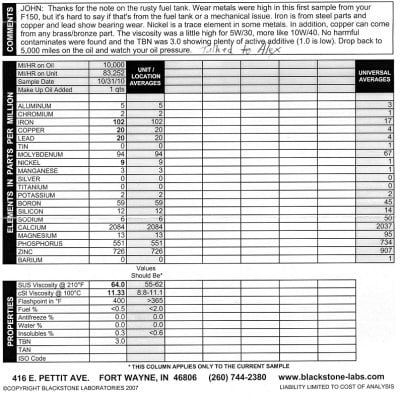This is for real gear heads, including me.
After limping 7,600 miles across the American continent and back with a rusty fuel tank, numerous clogged fuel filters and engine stopages, the tank was finally replaced with a brand new one, problem solved. The engine oil was analyzed to check for damage. After the next oil change, it will be analyzed again. This is a 1999 F-150 V6 4.2L with 5 speed manual with about 80,000 miles hauling a Keystone. We also wanted to see if 10,000 miles was a reasonable oil change frequency.
Total on this oil was 10,000 miles with one quart make up oil. Mobile 1 5W30
Any comments will be very much appreciated. The technician does not know for certain what the results mean. We will know more after the next analysis. Any opinions about these first results will be of interest. We have some smart people in this forum, so lets see some ideas.
John D
After limping 7,600 miles across the American continent and back with a rusty fuel tank, numerous clogged fuel filters and engine stopages, the tank was finally replaced with a brand new one, problem solved. The engine oil was analyzed to check for damage. After the next oil change, it will be analyzed again. This is a 1999 F-150 V6 4.2L with 5 speed manual with about 80,000 miles hauling a Keystone. We also wanted to see if 10,000 miles was a reasonable oil change frequency.
Total on this oil was 10,000 miles with one quart make up oil. Mobile 1 5W30
Any comments will be very much appreciated. The technician does not know for certain what the results mean. We will know more after the next analysis. Any opinions about these first results will be of interest. We have some smart people in this forum, so lets see some ideas.
John D

